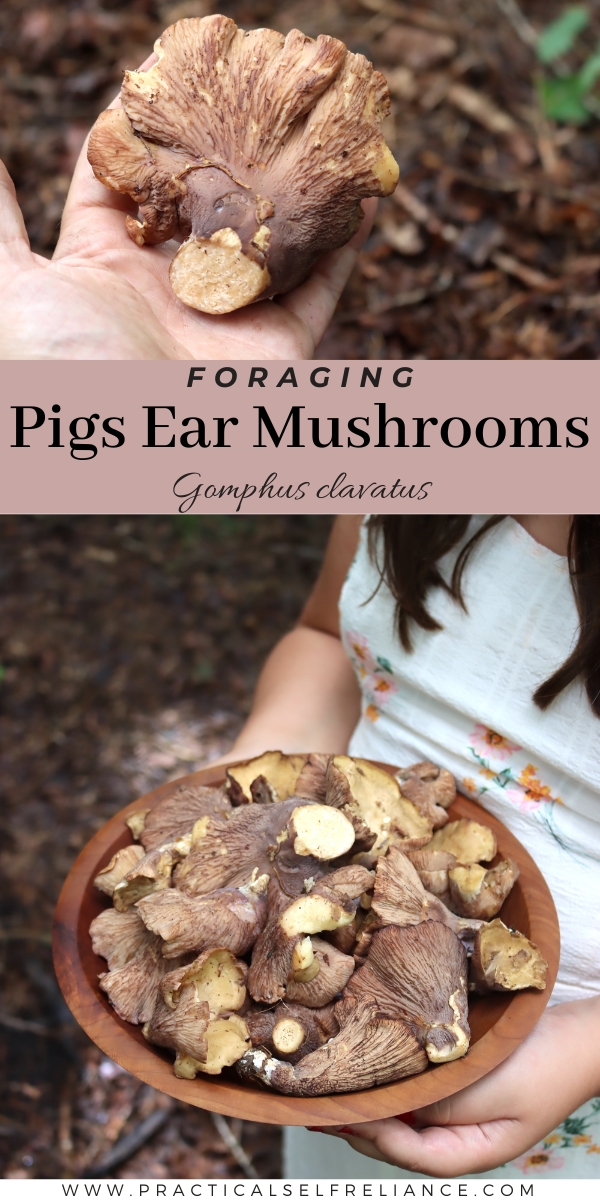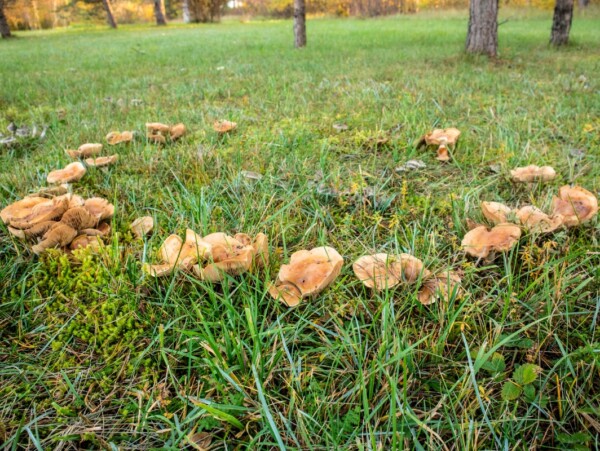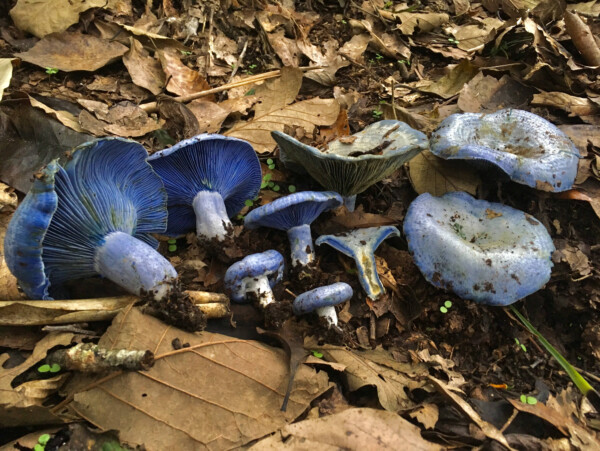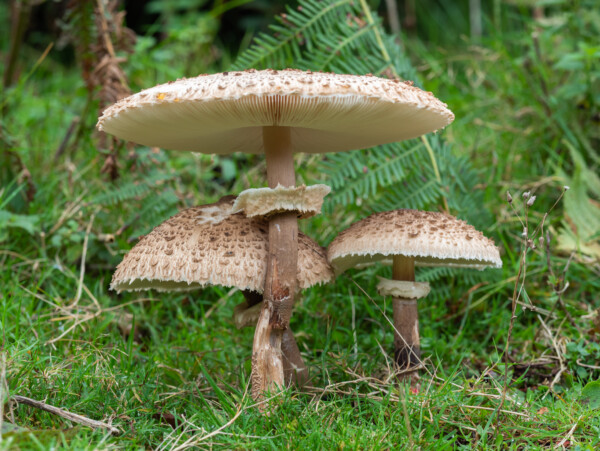Affiliate disclosure: This post may contain affiliate links. Please see our Privacy Policy.
Pigs Ear mushrooms are a rare treat, and they’re one of those old-fashioned mushrooms that your great aunt or grandmother has fond memories of foraging in the old country. These days, they’re a rare treat, as they’re associated with old-growth forests.
Still, there are rich patches out there in the woods, and they can be found and harvested if collected mindfully.
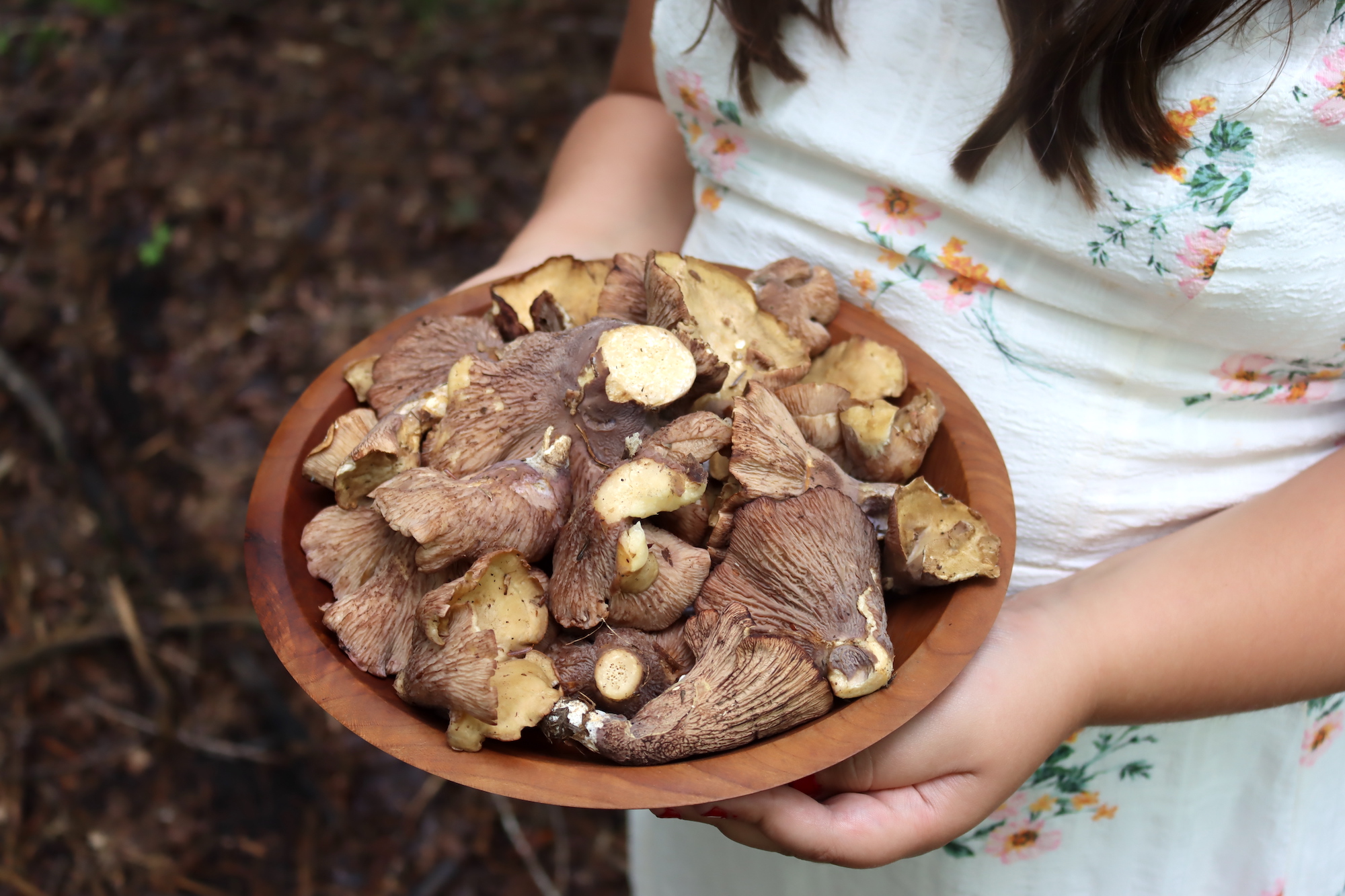
Pigs ear mushrooms are the type of mushrooms that old, experienced foragers tell stories about around the holiday table. One of those treats that was once abundant and freely collected, but now is incredibly rare.
Contrary to what you might think, they’re not rare due to overharvesting. In fact, harvesting them in a mesh bag and carrying them around the forest with you only helps their cause and spreads their spores.
They’re rare due to habitat loss, as they’re most commonly associated with old-growth forests. The spores are long-lived, and so is the mycelium, and they are coming back in areas where the forests are maturing once again.
Here in Vermont, they can be found in abundance in the right place, when the conditions are right. Heavy rains, as we had in this record rain summer in 2023, created just those perfect conditions.
Add in the fact that Vermont is reforesting at an incredible rate, with more than 70% of the land area in timber, and you have a recipe for a success story (and a tasty meal at the same time).
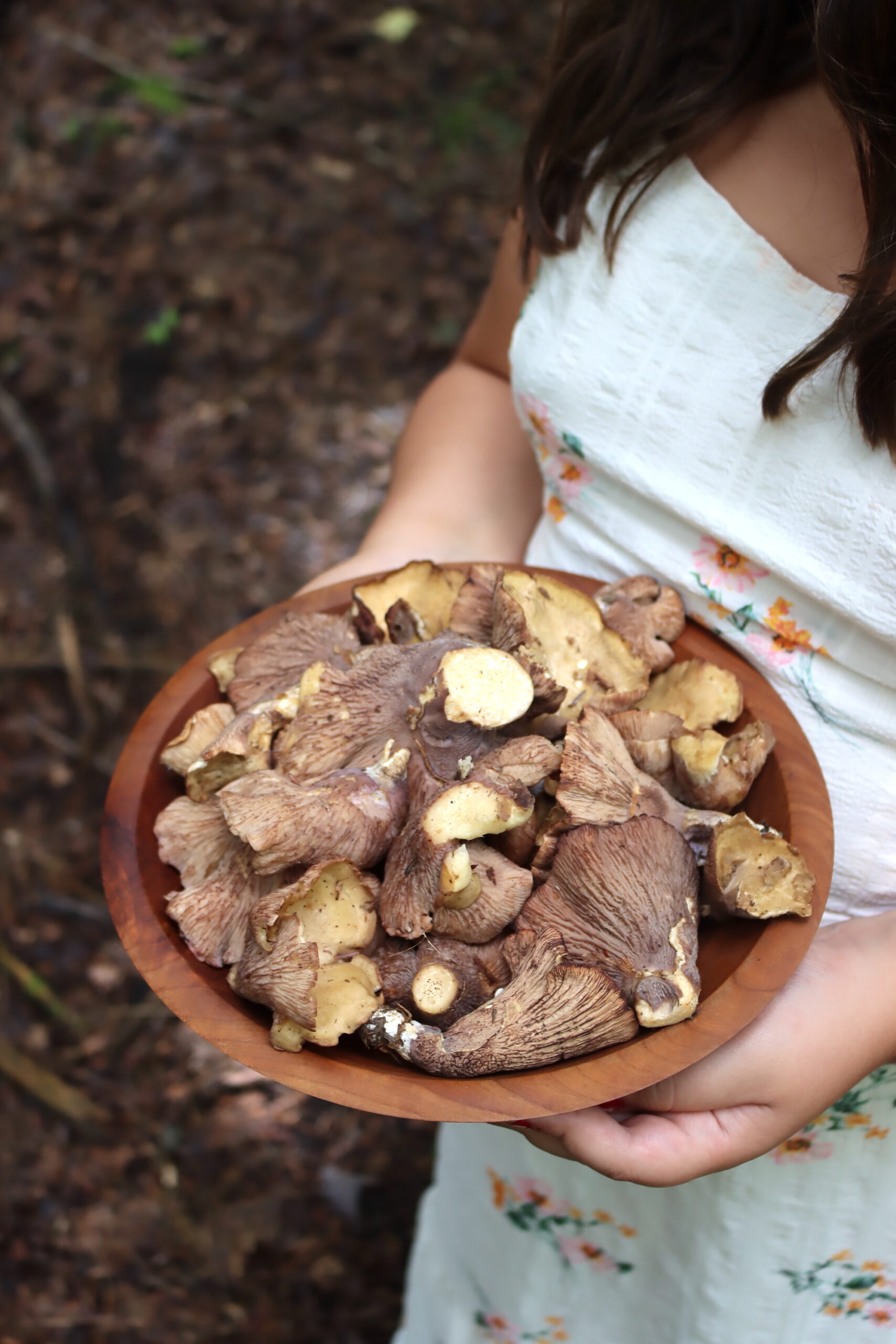
This article was written by Timo Mendez, a freelance writer and amateur mycologist who has foraged wild mushrooms all over the world.
Sometimes, the most exciting mushrooms to find are the ones you most seldom see. The strange, the rare, and the obscure ones, which you may only see once or twice in a season. One’s you’ll never see in a grocery store, and that even knowledgeable foragers don’t seem to harvest.
Pigs Ear Mushroom, known scientifically as Gomphus clavatus, is one of these infrequent species. It is considered a popular choice by many foragers and a spectacular sight to see. While it has a wide distribution and occurs in many different bio-regions, its incidence within them is rather limited. It’s not like Chanterelles or Boletes, which can sometimes dot the forest with their presence.
As a matter of fact, Pigs Ears mushroom is considered a threatened fungus in 17 different countries, and it even has legal protection in some. In the British Isles, this mushroom was last seen in 1927 and is now considered extinct. The exact reason for its decline in sightings has not been studied in-depth but is likely related to habitat loss and pollution. In many regions, it is considered to be associated with well-aged trees and old-growth forests.
This beautiful mushroom is also sometimes known as the ¨Violet Chanterelle¨ due to its striking purple color and similarity to the chanterelle. While it does have the ridge-like false gills of a chanterelle and sometimes even a familiar growth structure, the reality is that it’s not even remotely related to chanterelles. They don’t have the aroma or the texture, and they´re in a completely different lineage of mushrooms.
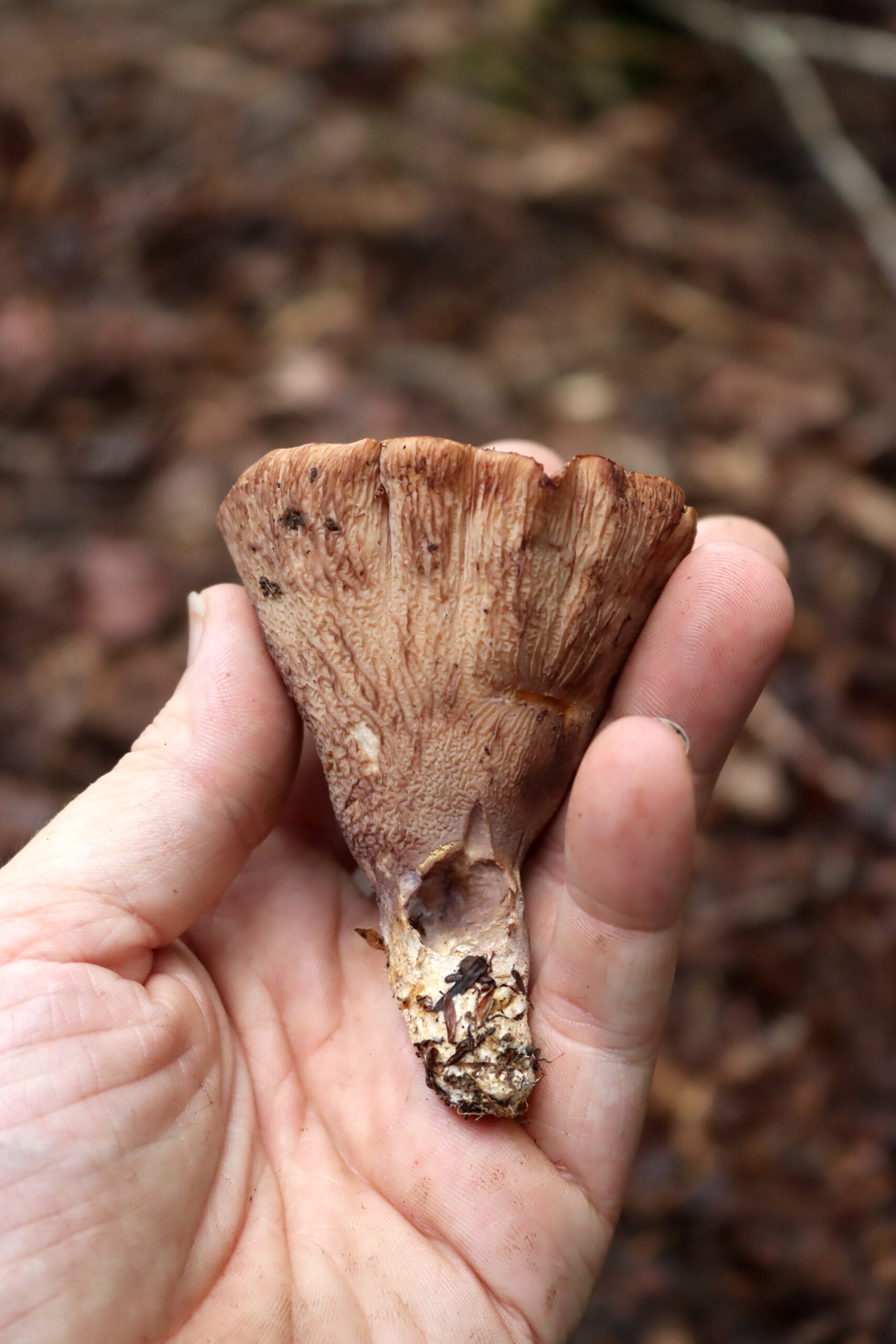
Natural History Of Pigs Ear Mushrooms
Like many of the world’s favorite edible mushrooms, Pigs Ears only grow thanks to a symbiosis between them and specific host trees. These are known as “Mycorrhizal Relationships” and entail an exchange of energy and nutrients between fungi and trees. This specific lifestyle of the fungus is one of the reasons why these mushrooms are impossible to cultivate.
While the most commonly used name for Pigs Ears mushrooms is Gomphus clavatus, it is well known that there are various similar-looking species in the genus Gomphus. Some of these species have been analyzed and described as new species, while others continue to fall under the name Gomphus clavatus. Since this species was described in Europe, it is likely that Gomphus clavatus may not even really occur in the Americas, despite all the field books using this name.
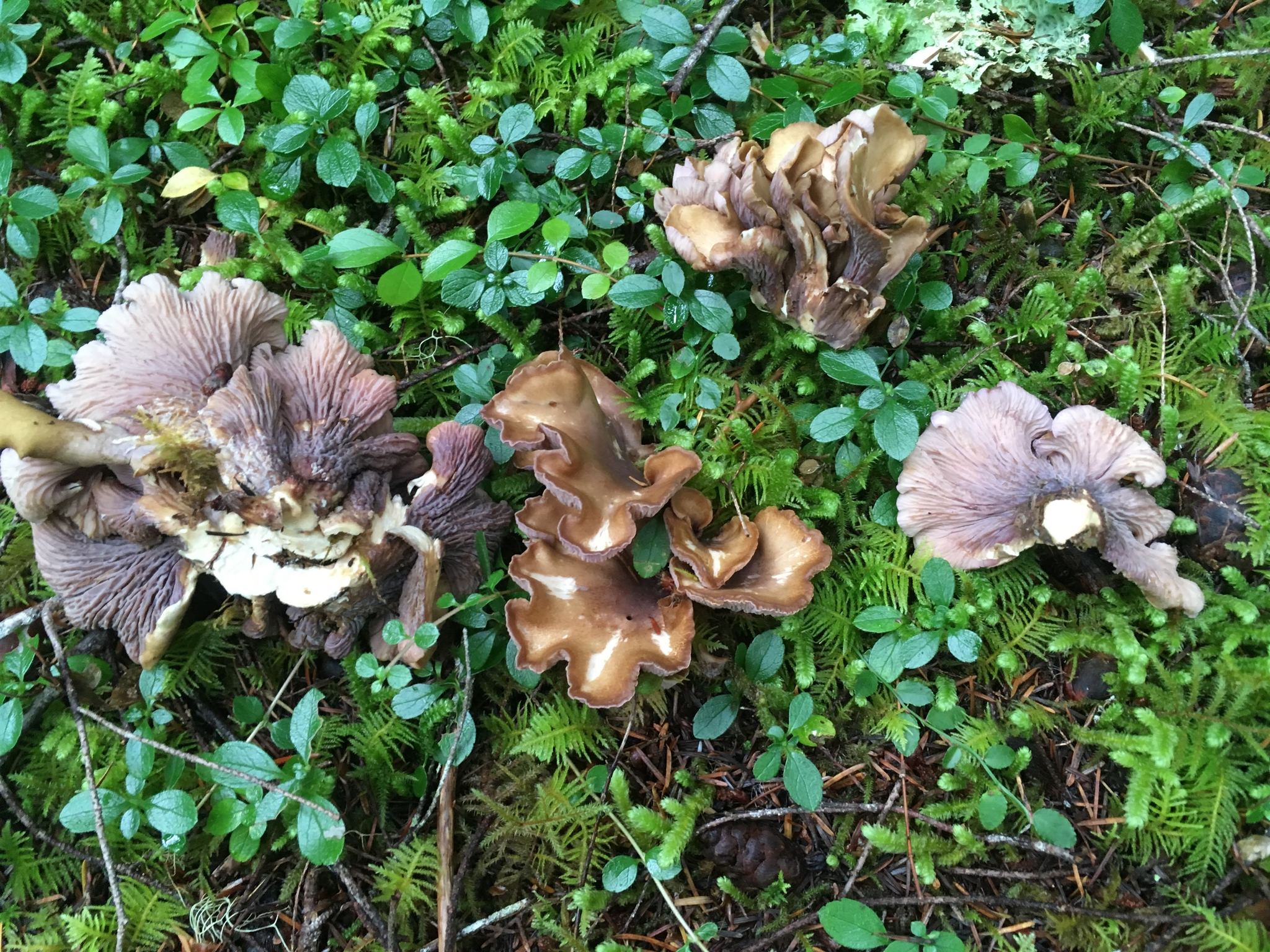
Host Trees of Pigs Ears Mushrooms
The known tree hosts for Gomphus clavatus include True Firs (Abies sp.), Spruce (Picea sp.), Douglas Fir (Pseudotsuga menziesii), Western Hemlock (Tsuga heterophylla), and Pine (Pinus sp.). There is a second species known as Gomphus ludovicianus, which looks pretty much identical but occurs with oak and other hardwoods in the eastern United States. This second species is pretty rare but also appears to be widely distributed in the eastern United States.
Lastly, there is another strange “Pigs Ear” mushroom whose identity is not entirely clear. The name currently suggested for this species is Pseudocraterellus pseudoclavatus (you know some things up when both parts of the name are “pseudo”), which means that this is a close relative of the Chanterelle. While to the naked eye, it apparently looks just like a Pigs Ear, it looks more like a Chanterelle under a microscope. To further confuse things, some sources (such as David Aroras Mushrooms Demystified) suggest this species grows with hardwoods, while others (1, 2) say it grows under conifers. I’ve never seen it, nor are there many verified photos of the species, so it’s hard to make a judgment. It will hopefully be resolved with genetic testing in the near future.
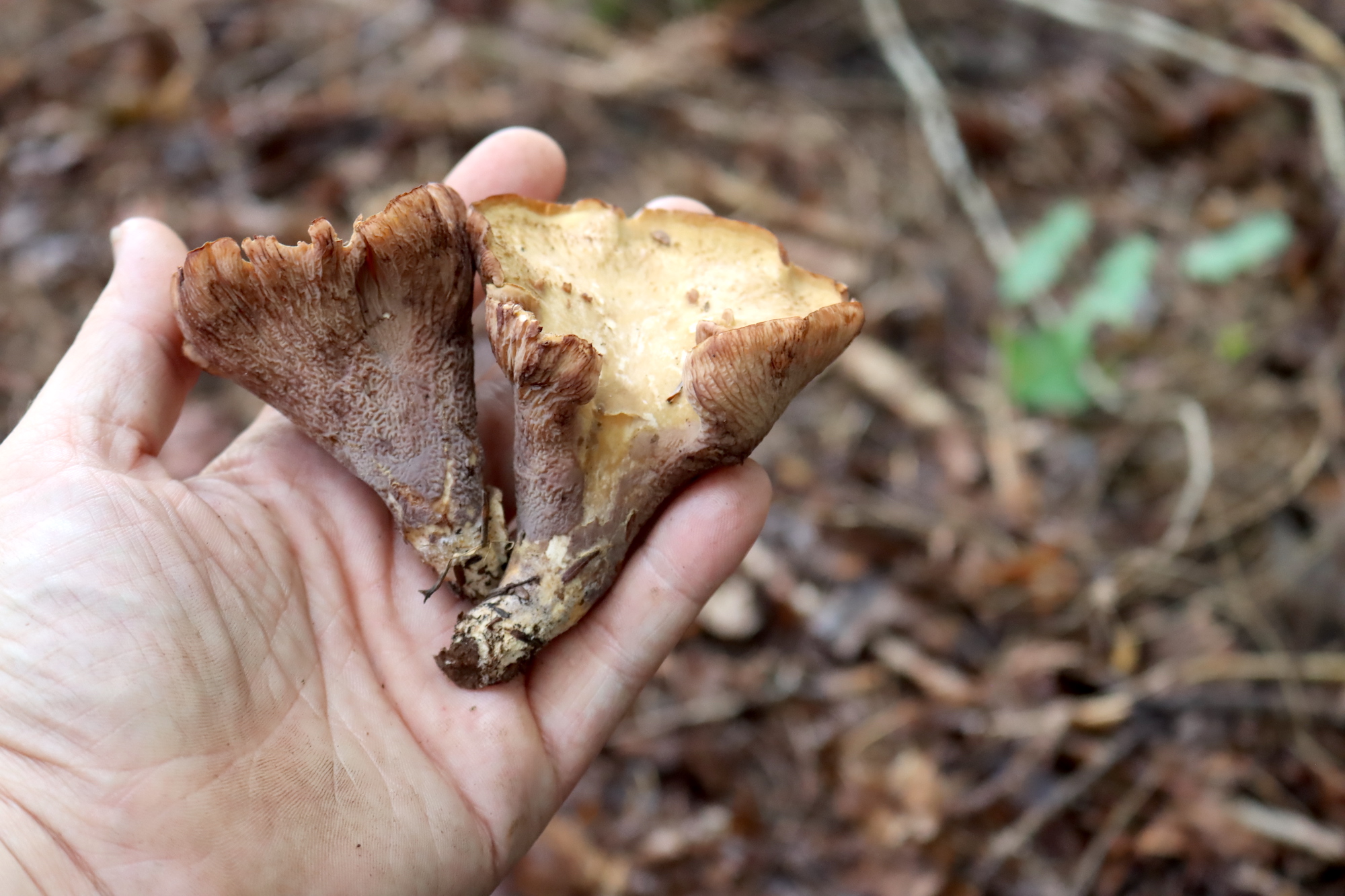
Where To Find Pigs Ear Mushrooms
Pigs Ear Mushrooms are found in the Northern Hemisphere and are primarily associated with conifers, although some species do associate with hardwood forests. In the Americas, they are found most abundantly in the Pacific Northwest and Northeastern North America. This being said, they can be found in the Great Lakes Region, the Appalachians, the Northern Rockies, and have even been reported in Florida. They also occur in mountainous regions of Mexico and Central America.
They occur in most European countries, though pretty infrequently in most. Mountainous regions like the Alps and Pyrenees are considered some of the best places to find Pigs Ear in Europe. They are also known in northern Africa and Asia.
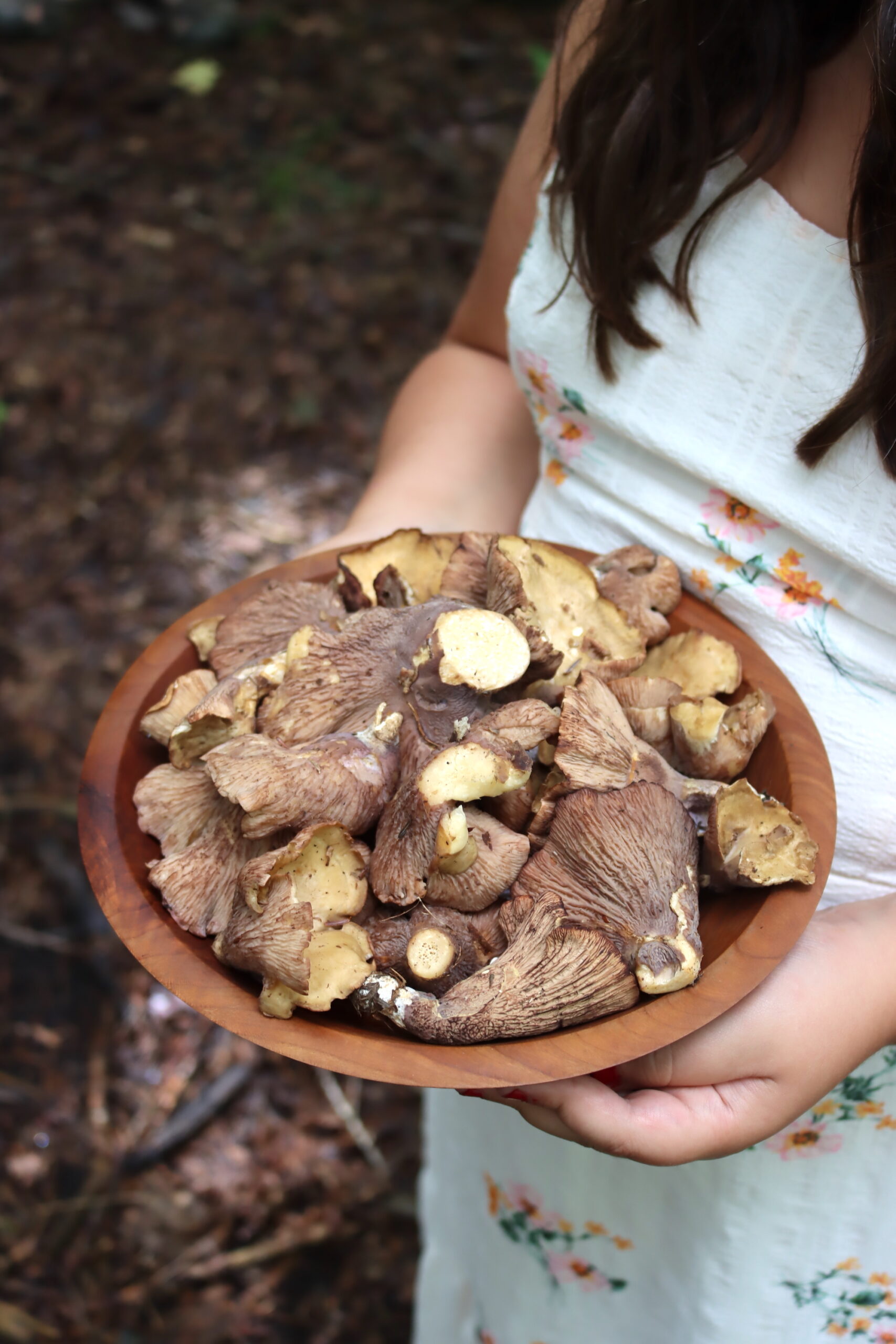
Western North America
Pigs Ears can be found along the coast north of San Francisco up into Canada. Here, it grows in coniferous forests, associating mostly with Spruce and Hemlock. It is largely absent from the Sierra Nevadas but readily found in the Cascades and the Rocky Mountains.
The coniferous forests of Oregon, Washington, and southwestern British Columbia are considered relative hot spots for Pigs Ears.
Eastern North America
Pigs Ears occur throughout Eastern North America, although they’re most common across the northern latitudes. They readily occur around the Great Lakes and up into the Northeast. Their range extends down along the Appalachian mountains and its foothills.
Reports of the hardwood associated with Pigs Ear (Gomphus ludovicianus) have been made down to Florida.
Europe
This species is pretty rare in Europe, and as previously mentioned, is considered endangered in various countries. While the extent of the range is known to occur from Finland down to Spain, reports are pretty scarce in most regions.
Where they seem to occur most often is in montane habitats like the Alps and the Pyrenees.
Other Parts Of The World
Pigs Ear mushrooms can be found in mountainous parts of Mexico and Central America. They may be quite rare and distinct species from those found in other regions.
They also occur in northern Africa as a distinct species known as Gomphus crassipes. Various species are known from Asia and in China, Nepal, and other countries they are valued edibles.
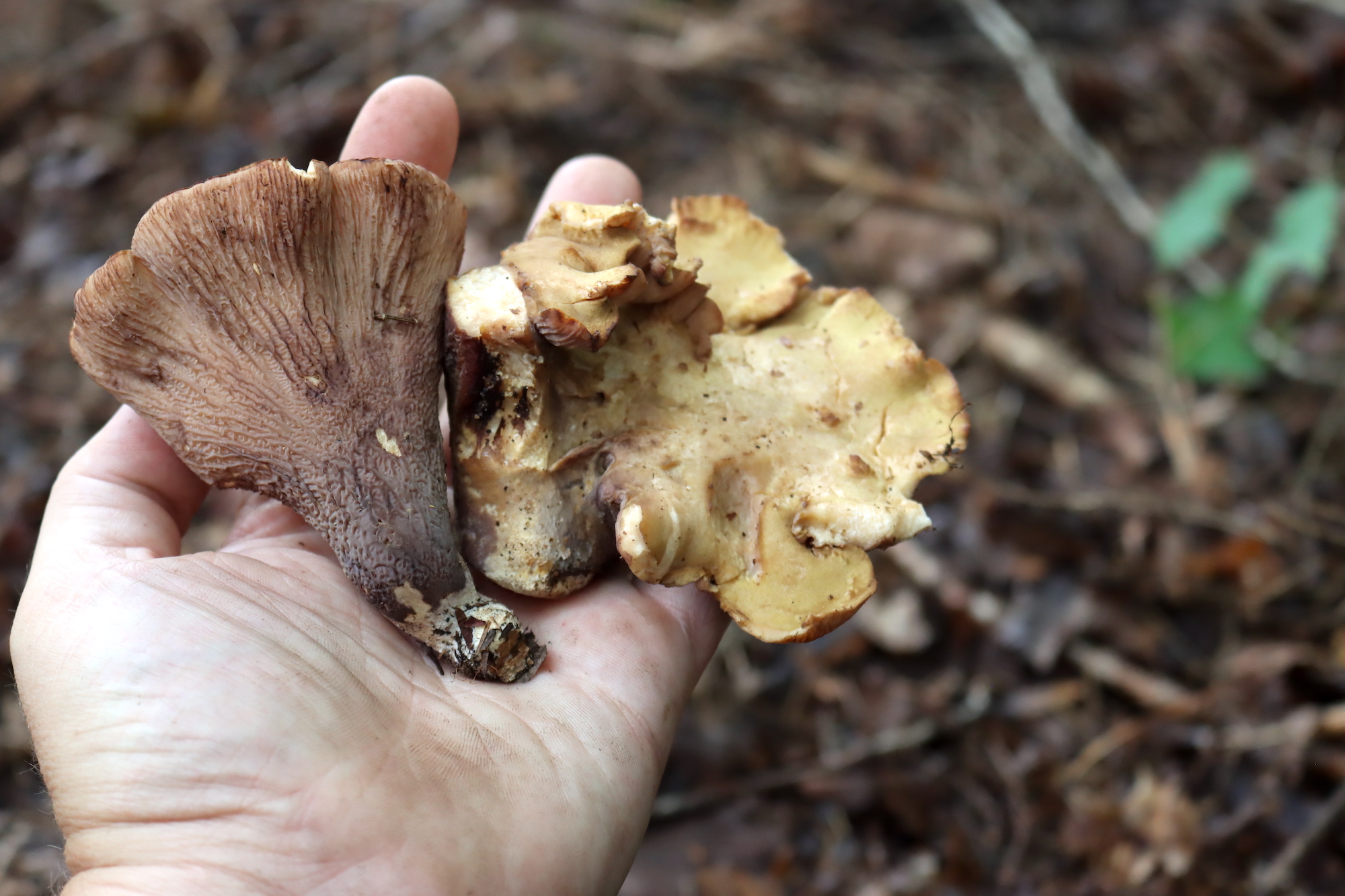
When To Find Pigs Ears Mushrooms
Generally speaking, Pigs Ears tend to fruit from late summer into fall. This varies depending on location and species.
- California (Oct – Feb)
Here, the season starts in the fall and can continue through the winter into February. - Pacific Northwest (Aug – Nov)
In Oregon, Washington, and British Columbia, the season starts in the late summer and can extend into November in temperate coastal regions. - Rocky Mountains (July – October)
Here, the season generally occurs during summer monsoons and peaks in August. - Great Lakes Region (July – October)
In the Great Lakes region, the season peaks between August and September.
- Northeastern United States and Canada (July – October)
Here, the season starts in mid-summer and goes into fall. The season typically lasts longer in the lower latitudes and regions with slightly warmer climates. - Appalachian Mountains (June – October)
In the Appalachians, they can be found as early as May and into November, but the peak season is late summer and fall. - Europe (June – October)
In mountainous regions where they most occur, they flourish in the summer monsoons, while in zones with mild climates, they tend to fruit more in fall.
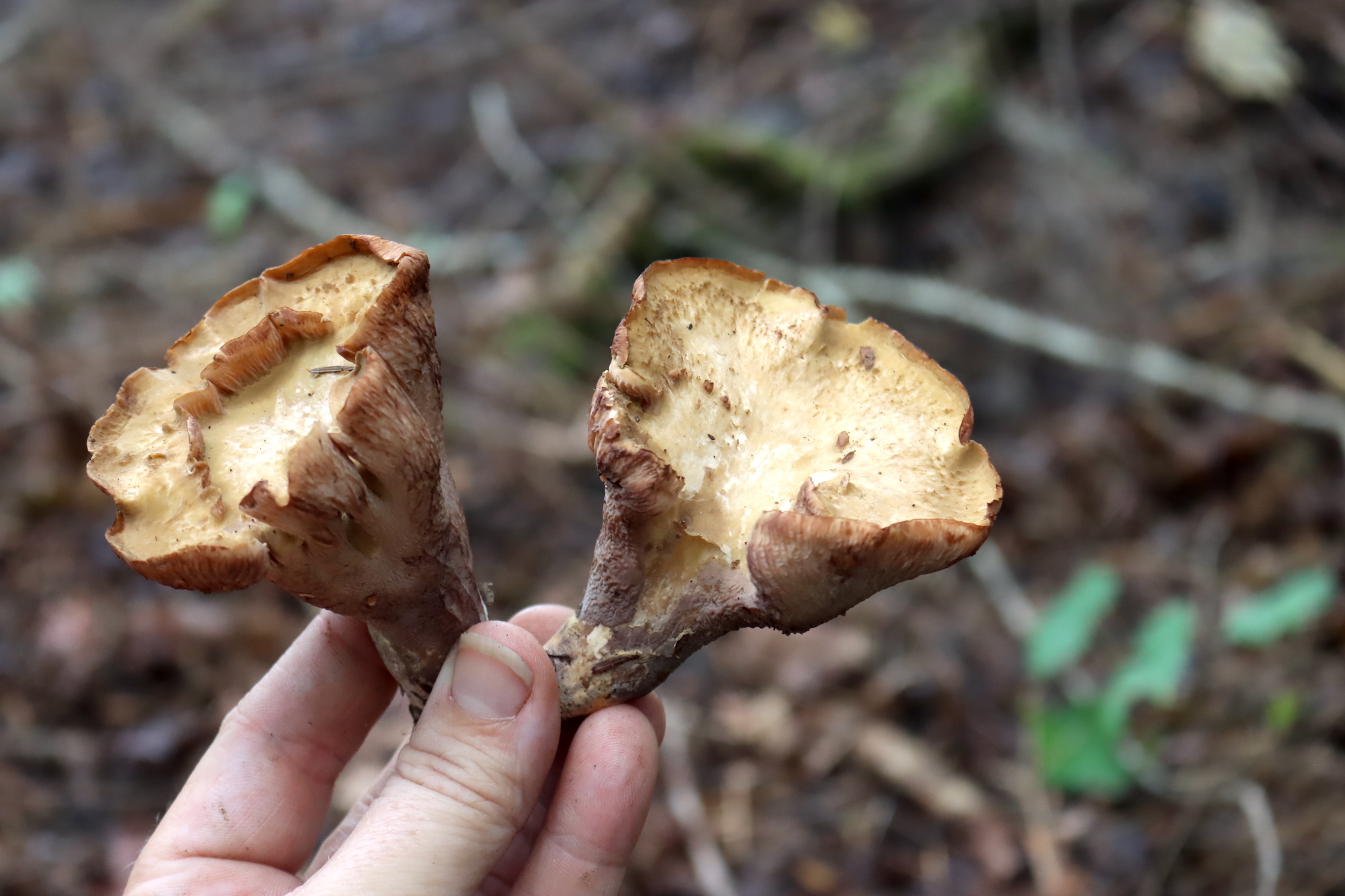
How To Harvest Pigs Ears Mushrooms
Foraging anything from the wild should always be done with care and respect. Don’t litter or cause unnecessary damage to the ecosystem, and always try to leave the smallest impact as possible (unless you’re removing invasive species or doing beneficial management of course!). Harvest with permission if necessary, and make sure to respect other users/foragers/walkers and whomever else may be using the forest.
I think it is important to take extra-extra care with this species, as it is well known to be relatively rare and likely sensitive to human impacts. In areas where this species is endangered or has levels of protection, it may be illegal to harvest this mushroom.
Once you finally find a Pigs Ear and begin approaching it, walk carefully and make sure not to step on any mushrooms. They can grow in patches, and young mushrooms can easily hide away beneath leaf litter. It’s always good to take a second and admire the mushroom before harvesting. Take a picture if warranted.
Part of respectful harvesting involves harvesting only what you need and not taking everything. One of my rules is to always leave the first patch you find of a specific species, especially if it’s just a single or few mushrooms. Once you find a second or third patch, you know there’s probably a decent fruiting this year and harvesting won’t do much harm. I like to think it’s good luck too, but that’s just a mushroom hunter’s superstition.
When it comes to harvesting, go for any nice looking middle-aged mushrooms. Leave the small ones to grow and those that are past their prime. Pig’s Ears are notorious for having larvae, so it is pretty important to find them while they are still intact. You can gently squeeze the mushroom before harvesting; if it feels firm, it’s probably good to go. If it’s soft, then it’s past its point. Honestly, I’ve never found specimens that don’t have any larvae. I still eat them, but I know some folks are uncomfortable with that.
I’ve discussed this in articles prior, but there is a whole debate regarding whether it’s best to pick or cut mushrooms. The few studies that have been done on this show no significant difference, although there are advocates in both camps. I just do what’s easier. For mushrooms with small stems, I think it’s easier to cut, but with those like Pigs Ears, I pick and then clean the stem butt with my knife. It’s always important to remove as much dirt as possible before placing it in your bag/basket. This will greatly reduce the time you spend cleaning them once you’re back home.
While we are on that topic, it’s recommended to pick with a basket. This not only helps keep your mushrooms more intact, but it’s believed to help further disperse the spores through the forest as you walk.
Once you make it home, keep your mushrooms in a dry and cool place. You should ideally cook or process them the same day, if not 2-3 days of storage at the latest. Chances are they have larvae or eggs in them already, so they won’t last too long, even in the fridge.

Identifying Pigs Ear Mushroom
Identifying Pigs Ears is pretty darn easy, and there aren’t too many species that you could easily mistake it for.
From afar, the first thing you will notice is the stunning purple color. It is contrasted with the cap surface, which has a tan, fleshy color. I’m not too certain about the origins of the name, but I think it’s the color and general shape of the cap that give it this name.
The mushrooms are vase-shaped, clustered, and pretty chunky. They can grow up to be 17 cm in height and almost equally wide. You rarely ever find a single mushroom growing alone, but they tend to grow from cespitose clusters that form a sort of bouquet of mushrooms. If it’s a good patch, there will be various clusters.
The mushroom itself has ridge-like veins, or “false gills,” that run down to the base of the mushroom, very much like chanterelles. The cap itself is cup-shaped with a wavy, undulating margin. The cap surface can be slightly velvety or felt like.
The flesh is firm, tough, and perfectly solid through the center. The flesh is typically purple but ranges in intensity from whitish to tan. The flesh may bruise a brown color when handled. It typically doesn’t have a strong odor or taste.
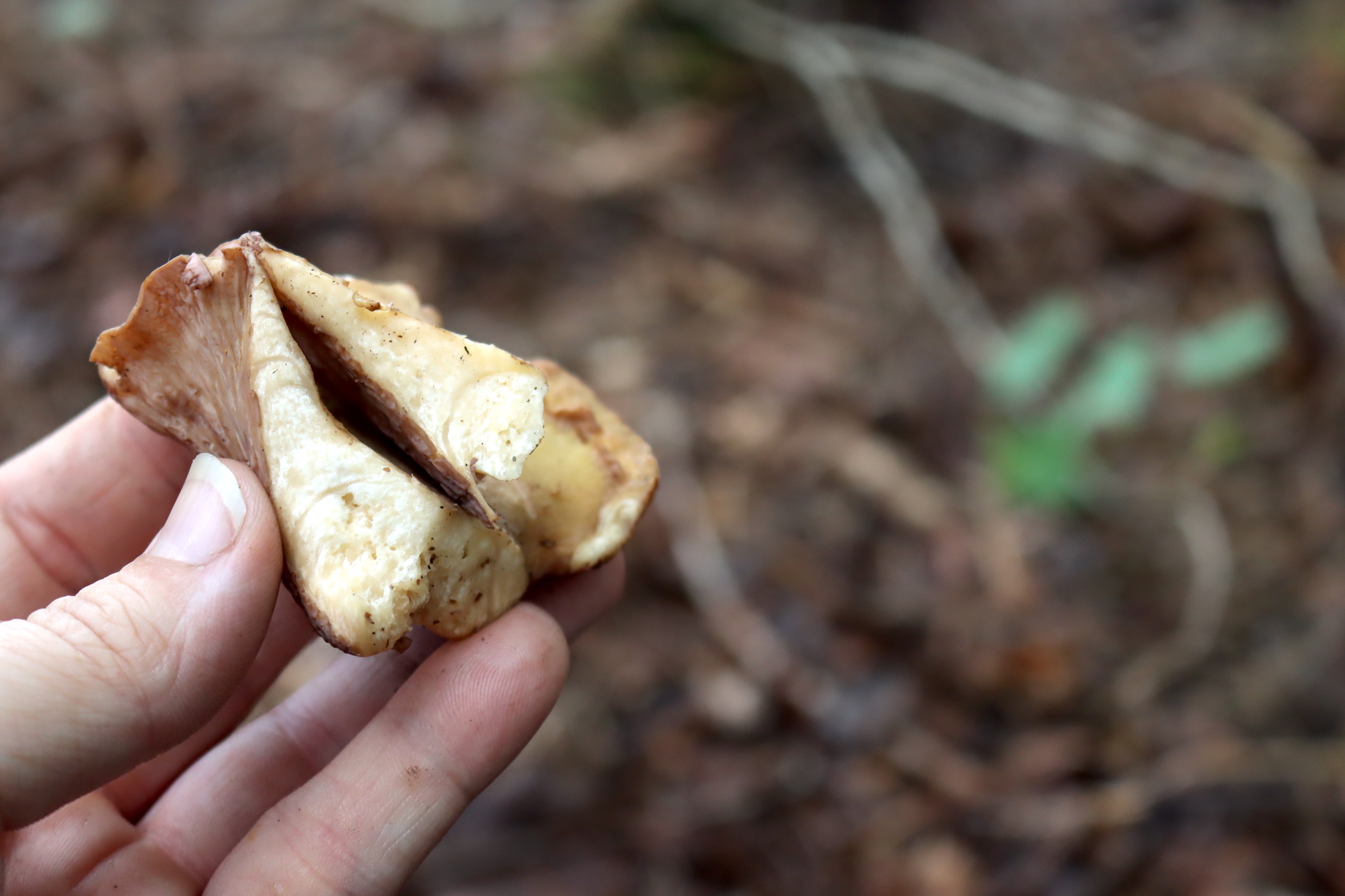
Identification Features For Pigs Ear Mushroom
- Purple color
- Tan, fleshy cap surface with touches of purple
- Vase-shaped and clustered
- Ridge-like veins on the outside (false gills)
- Cup-shaped cap with wavy edge
- Slightly velvety cap surface
- Mild taste and odor
- Yellow to orange-yellow spore print
Pigs Ear Lookalikes
There aren’t too many Pigs Ear lookalikes out there. It’s pretty safe for beginners because of this, but just in case you have any doubts compare it to the following species.
Blue Chanterelle (Polyozellus multiplex)
This mushroom has some similarities in structure, although it really resembles a black trumpet mushroom in color. This coloring is a quick giveaway that it’s not a Pigs Ear.
It is much fleshier than Black Trumpets but not quite as fleshy and thick as the Pigs Ears. This species is edible, but even rarer than Pigs Ears!
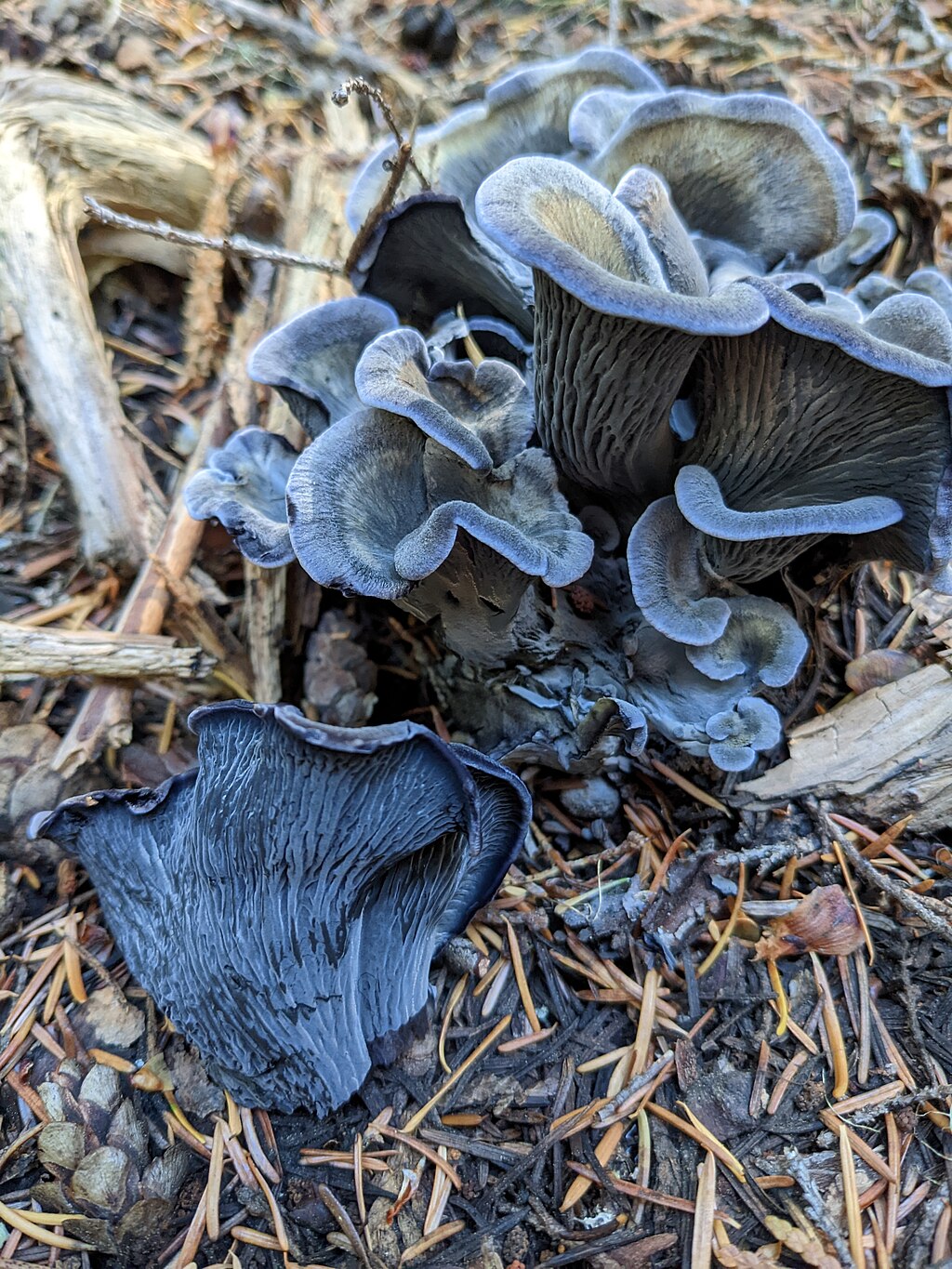
Scaly Vase (Turbinellus sp.)
These mushrooms are also very similar in structure and features but with a yellow-orange coloring. The cap often has the color of burned cheese.
It is closely related to Pigs Ears, although this mushroom is considered toxic in the US/Europe and is consumed (through proper preparation only) in different parts of the world.

How To Use Pigs Ear Mushrooms
Pigs Ear mushrooms can pretty much be cooked in any way you imagine. They don’t have a strong flavor but a nice texture, so the flavors will be determined largely by other ingredients.
This being said, every mushroom has a flavor, even if it is subtle. I always recommend that if it’s your first time cooking a mushroom, simply chop it into medium-sized slices/pieces and sear it with a bit of salt, oil, and pepper. You can serve it with a couple of slices of lime. This way, you can taste it in a relatively “neutral” way to see if anything inspires you. You can add them to soups, stir-fries, and pasta, or even cook-them and add it to salads.
I find that Asian-style soups are great for this mushroom. I always like to slightly sear the mushrooms before throwing them into a simmering pot of soup, but you can also just cook them directly in the broth. I’ve never done it before, but I can also imagine this mushroom taking pretty well to being marinaded. It can also be great to just cook this separately in a pan and garnish any recipe of your choice with it.
It is important to always thoroughly cook Pigs Ear, and almost any other edible mushroom, for that matter. While Pigs Ear isn’t known to be toxic raw, it is well known that raw mushrooms are difficult to digest.
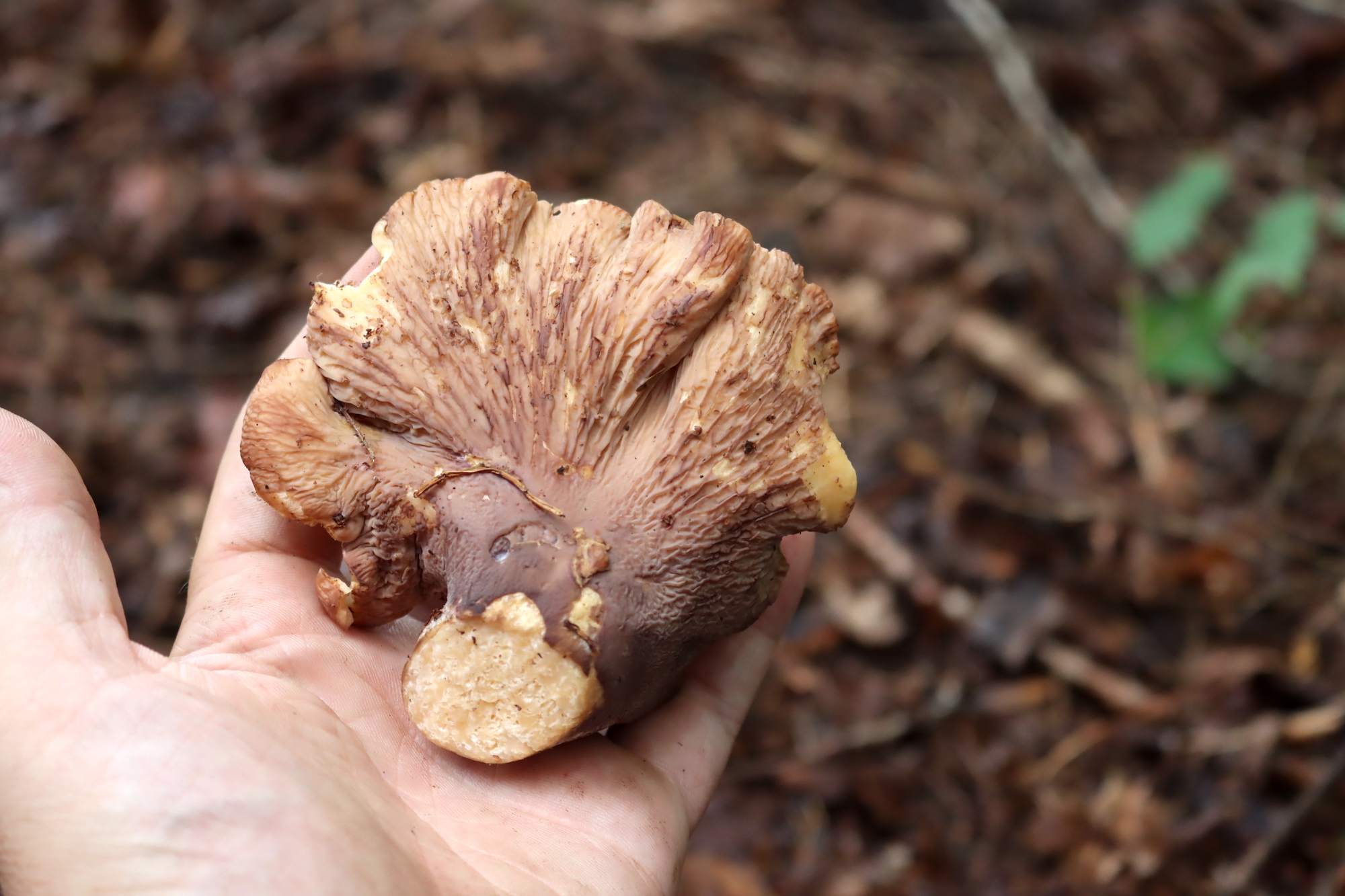
Preserving Pigs Ear
I’ll have to be honest; I’ve never had so many Pigs Ear to the point where I’ve had the privilege of having to preserve them. I just don’t find them that abundantly, nor do most folks. It’s a bit hard to judge what the best ways to preserve them would be. One thing is true though, if you find a lot you should either eat them right away or preserve them. As I mentioned previously, these almost always have larvae that will voraciously eat away at your mushrooms if you try to keep them for too long.
One preservation method that is easy and almost always certain is to cook and freeze them. Simply put them in a pan, wait for the water to come out of the mushrooms, and simmer them in their juices for 4-5 minutes. After this let it cool down and freeze them. When you want to add Pig’s Ear to something, you just need to defrost them.
My intuition based on other similar mushrooms is that this mushroom probably doesn’t rehydrate well after being dried. It’s already a pretty solid consistency, which often means it just stays tough and rubbery once it dries out. This being said, you could always powder it and use it to flavor soups and sauces. It would also be an interesting mushroom to make into jerky. I have a feeling this mushroom would work well in pickles because of its tough consistency and lack of mucilage.
Mushroom Identification Guides
These mushroom ID guides will keep you busy in the woods!
- Morel Mushrooms
- Chaga Mushrooms
- Birch Polypore
- Tinder Polypore
- Witches Butter Mushrooms
- Puffball Mushrooms
- Shaggy Mane Mushrooms
- Reishi Mushrooms
- Turkey Tail Mushrooms
- Dryad’s Saddle
- Cauliflower Mushrooms
- Yellowfoot Chanterelles
- Saffron Milk Caps
